Keith Allen Haring (May 4, 1958 – February 16, 1990) was an American artist whose work of pop art and graffiti emerged from the street culture of New York City in the eighties.
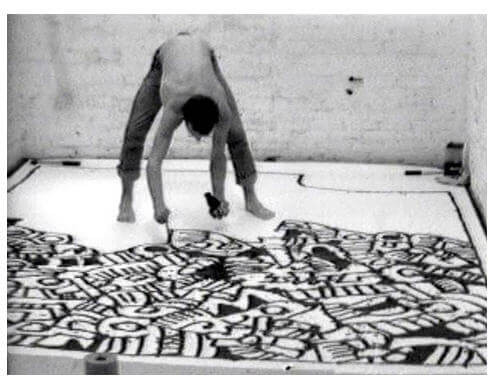
Haring’s work grew to the iconic popularity of his lush, spontaneous drawings on the New York City subway: chalk outlines on backgrounds of blank black advertising spaces, showing radiant babies, flying saucers and deified dogs. After public recognition, he created works on a larger scale, such as colorful murals, many of them commissioned. His images have become a widely recognized visual language. His later work often addressed political and social issues, especially homosexuality and AIDS, through his own unique iconography.
Early age and education
Keith Haring was born in Reading, Pennsylvania, on May 4, 1958. He was raised in Kutztown, Pennsylvania, by his mother, Joan Haring, and his father Allen Haring, an amateur engineer and draftsman. His family attended the United Church of God. He had three younger sisters, Kay, Karen and Kristen. He became interested in art at a very young age by spending time with his father producing creative drawings. His early influences include Walt Disney caricatures, Dr. Seuss, Charles Schulz, and the Looney Tunes characters on The Bugs Bunny Show.
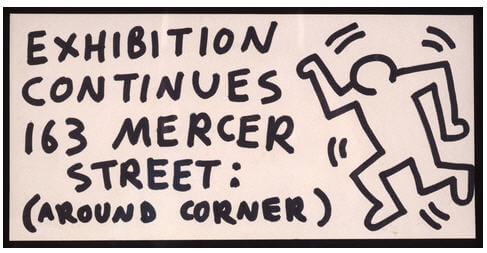
In his early teens, Haring was involved with the Jesus Movement. Eventually he left behind his religious background and hitchhiked across the country, selling vintage t-shirts and experimenting with drugs. He studied commercial art from 1976 to 1978 at the Ivy School of Professional Art in Pittsburgh, but lost interest in it. He made the decision to leave after reading The Art Spirit (1923), by Robert Henri, which inspired him to concentrate on his own art.
Haring had a maintenance job at the Pittsburgh Arts Center and was able to explore the art of Jean Dubuffet, Jackson Pollock and Mark Tobey. His most critical influences at this time were a 1977 retrospective of the work of Pierre Alechinsky and a lecture by sculptor Christo in 1978. Alechinsky’s work, connected with the international expressionist group CoBrA, gave him confidence to create larger paintings of images calligraphic Christo presented the possibilities of involving the public with his art. His first major solo exhibition was in Pittsburgh at the Center for the Arts in 1978.
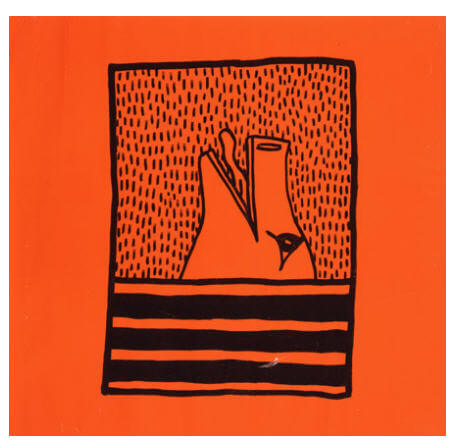
He moved to New York in 1978 to study painting at the School of Visual Arts. He also worked as a waiter during this time in a nightclub called Danceteria. He studied semiotics with Bill Beckley and also explored the possibilities of video and performance. Deeply influenced at this time by the writings of William Burroughs, he was inspired to experiment with cross-reference and interconnected images. In his last year of high school, he was behind in credits, because his teachers could not give him credit for the very loose work he was doing with issues of social activism.
Early work
First he received public attention with his public art on the subway, where he created drawings of white chalk on a black board, unused, in the stations. Keith considered the subway to be his “laboratory,” a place where he could experiment and create his work of art. Starting in 1980, he organized exhibitions at Club 57, which were filmed by photographer Tseng Kwong Chi. Around this time, “The Radiant Baby” became his symbol. Its bold lines, bright colors and active figures carry strong messages of life and unity. He participated in the Times Square exhibition and drew animals and human faces for the first time. That same year, he photocopied and pasted provocative collages made from cuts and recombined the headlines of the New York Post around the city. In 1981, he sketched his first chalk drawings on black paper and painted plastic, metal and found objects.
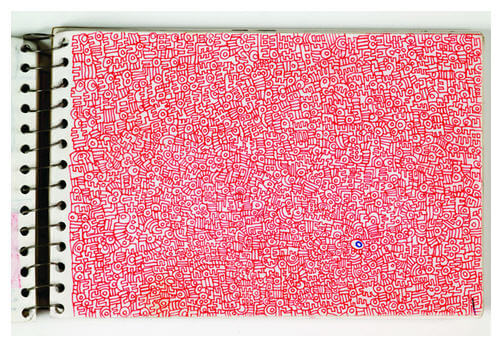
In 1982, Haring had established friendships with other emerging artists such as Futura 2000, Kenny Scharf, Madonna and Jean-Michel Basquiat. He created more than 50 public works between 1982 and 1989 in dozens of cities around the world. He often used energy lines to emphasize kinetic movement, vitality and euphoric spirit. One of his first works in 1982 shows two figures with a radiant love of the heart motif, which critics have interpreted as audacity in homosexual love and a significant cultural declaration. His mural “Crack is Wack”, created in 1986, is visible from FDR Drive in New York. In 1989, he criticized the avoidance of social problems such as AIDS through a piece called “Rebel with many causes” that revolves around a theme of “not listening to evil, not seeing evil, not talking badly”.
He got to know Andy Warhol, who was the subject of several of Haring’s pieces, including “Andy Mouse.” His friendship with Warhol would prove to be a decisive element in his eventual success. In December of 2007, it was discovered that an area of the American Textile Building in the TriBeCa neighborhood of New York City contained a painting by Haring’s from 1979.
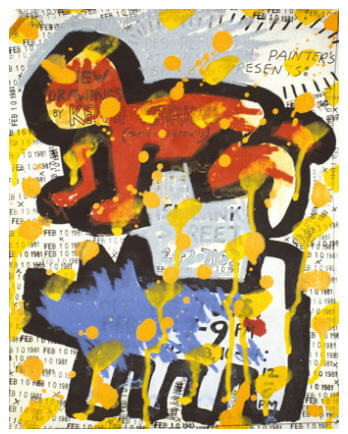
International advance
In 1984, Haring visited Australia and painted murals in Melbourne (such as the 1984 Detail-Mural at Collingwood College, Victoria) and Sydney, and received a commission from the National Gallery of Victoria and the Australian Center for Contemporary Art to create a mural that temporarily replaced the water curtain in the National Gallery. He also visited and painted in Rio de Janeiro, the Museum of Modern Art of the City of Paris, Minneapolis and Manhattan. He became politically active, designing a free South Africa poster in 1985. On October 23, 1986, the Checkpoint Charlie Museum asked Keith to create a mural on the Berlin Wall. The mural was 300 meters long and represented human figures interlaced red and black on a yellow background. The colors were a representation of the German flag and symbolized the hope of unity between East and West Germany. He was interested in working with children and this inspired the Citykids Speak on Liberty project, which involved 1,000 children who collaborated on a project for the centennial of the Statue of Liberty.
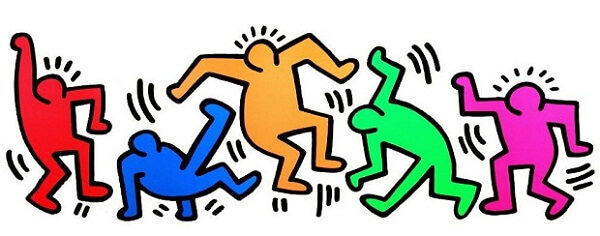
In April of 1986, the Pop store in Soho was opened and made Keith’s work accessible to buy at reasonable prices. When asked about the commercialism of his work, Haring said: “I could make more money if I just painted some things and raised the price.” My store is an extension of what I was doing in subway stations, breaking down barriers between art. high and low “. With the arrival of Pop Shop, his work began to reflect more socio-political issues, such as antiapartheid, AIDS awareness and the crack epidemic. He even created several pieces of pop art influenced by other products: Absolut Vodka, Lucky Strike cigarettes and Coca-Cola. In 1987 he had his own exhibitions in Helsinki, Antwerp and elsewhere. He also designed the cover of the album A Very Special Christmas, in which Madonna was included. In 1988 he joined a select group of artists whose work appeared on the wine label Chateau Mouton Rothschild.
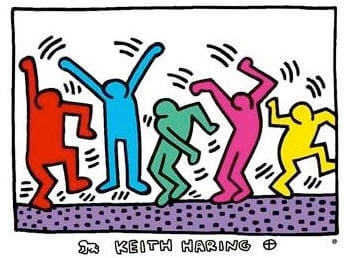
Haring also created public murals in the lobby and in the outpatient department of the Woodhull Medical and Mental Health Center on Flushing Avenue, Brooklyn.
A rare video of Haring at work shows his energetic style. He wrote: “I am becoming much more aware of the movement, the importance of the movement intensifies when a painting becomes a performance, the acting (the act of painting) becomes as important as the resulting painting.”
When his friend Jean-Michel Basquiat died of an overdose in New York in 1988, he paid tribute to his work A Pile of Crowns, for Jean-Michel Basquiat.
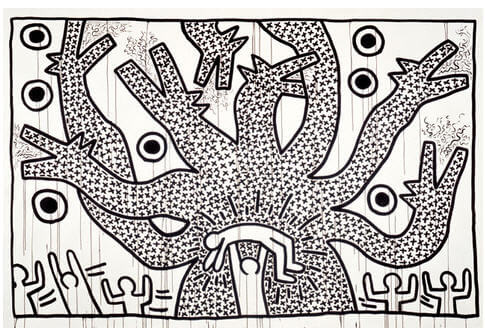
Haring was openly gay and was a strong advocate of safe sex; however, in 1988, he was diagnosed with AIDS. From 1982 to 1989, he appeared in more than 100 solo and group exhibitions, and produced more than 50 public works of art in dozens of charities, hospitals, nurseries and orphanages. He used his imagery during the last years of his life to talk about his illness and generate activism and awareness about AIDS. In 1989, he was invited by the Community Service Center for Lesbians and Gays to join a show of specific artwork for the building at 208 West 13th Street. He chose the men’s room on the second floor for his Once Upon a Time mural. In June, on the back wall of the convent of the Church of San Antonio (in Italian: Chiesa di Sant’Antonio abate) in Pisa (Italy), he painted the last public work of his life, the mural “Tuttomondo” (translation: ” All the world”)
Keith Haring Foundation
In 1989, he established the Keith Haring Foundation to provide funds and images to AIDS organizations and children’s programs, and to expand the audience of his work through exhibitions, publications and the licensing of his images. The foundation provides grants and funds to non-profit organizations that specifically focus on educating disadvantaged youth and informing people about HIV and AIDS. It also supports artistic and educational institutions by financing exhibitions, educational programs and publications. Haring also entrusted the foundation with the development of his legacy through research and the exchange of his works and materials related to his life.
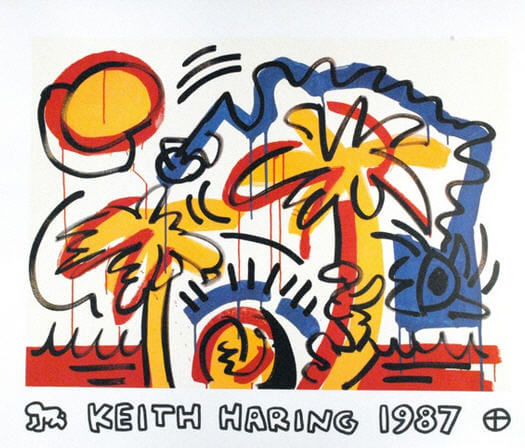
Fashion
He collaborated with Grace Jones, whom he met through Andy Warhol. In 1985, Haring and Jones worked together on Jones’ two live performances in Paradise Garage, which Robert Farris Thompson has called an “epicenter for black dance.” Each time, Haring covered Jones’ body with graffiti. He also collaborated with fashion designers Vivienne Westwood and Malcolm McLaren in his collection A / W 1983/84 Witches, with his artwork that covers the clothes that were most famous for a redhead Virgin for the interpretation of his song “Like a Virgin “on the British pop music show Top of the Pops and on the American television show Solid Gold. Haring also collaborated with David Spada, a jewelry designer, to design Jones’ sculptural ornaments.
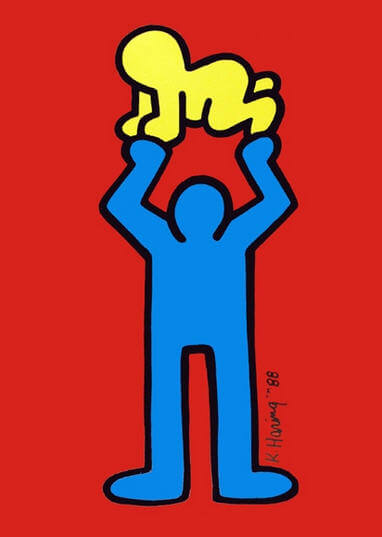
Influences
Haring’s work shows very clearly many important political and personal influences. Ideas about his sexual orientation are evident throughout his work and his diaries clearly confirm his impact on his work. The heavy symbolism that talks about the AIDS epidemic is vivid in his latest works, such as Untitled (Cat. No. 27), Silence = Death and his sketch Weeping Woman. In some of his works, including the cat. do not. 27-the symbolism is subtle, but also produced some openly activist works. Silence = Death, which reflects the ACT UP poster and uses its motto, is almost universally agreed upon as a work of activism against HIV / AIDS.
Diagnosis of AIDS
In July of 1987, he was a specialist in Harins. On May 1, 1987, he mentioned in his diary the rumors circulating throughout the artistic community about his state of AIDS. He wrote that his friend Tony Shafrazi was “still worried because the Art World gossip line still says that I have AIDS.” If something causes me tension and stress, it’s him, he does not stay up late or work hard, I live for work. “
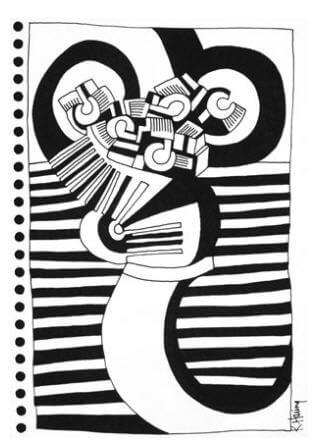
His diagnosis was never a secret; It was public knowledge and an accepted part of his person in the media. These publicly shared thoughts were reflected, often in more depth, in their work. Despite all the fear that led to the diagnosis, he somehow found that his imminent death was liberating. He pushed him to produce more work as quickly as possible. In a 1989 interview with Rolling Stone magazine, Haring stated, “That’s the point where I am now, not knowing where it is stopping, but knowing how important it is to do it now.” Everything is becoming more articulate. way is really liberating. ” Critics have recognized this about Haring’s works, particularly his later works as well. “Haring’s way of life, liberated and with death in mind at a young age, allowed him to move away from his diagnosis,” writes Blinderman. “A year after his original diagnosis, he was producing radiant paintings of birth and life.” The introduction to the compilation of Haring’s diaries expresses a similar opinion: “Haring accepts his death, in his art he found the key to transforming the desire, the force that killed him, into a flourishing elegance that will live beyond his time” .
Death
Keith Haring died on February 16, 1990 of complications related to AIDS.
As a celebration of her life, Madonna declared the first date in New York of her Blond Ambition World Tour a charity concert for the memory of Haring and donated all proceeds from her ticket sales to charities against AIDS, including AIDS Project Los Angeles and amfAR; The act was documented in his film Truth or Dare. In addition, her work was featured in several of Red Hot’s efforts to raise money for AIDS and AIDS awareness, specifically her first two albums, Red Hot + Blue and Red Hot + Dance, the latter using Haring’s work on its cover.
Exhibitions
Haring contributed to the New York New Wave exhibition in 1981 and in 1982, he had his first exclusive exhibition at the Tony Shafrazi Gallery. That same year, he participated in Documenta 7 in Kassel, Germany, as well as in “Messages to the public” of Public Art Fund, in which he created a job for a Spectacolor Board in Times Square. He contributed works to the Whitney Biennial in 1983, as well as to the São Paulo Biennial. In 1985, the CAPC in Bordeaux opened an exhibition of his works and participated in the Paris Biennial.
Since his death, Haring has been the subject of several international retrospectives. His art was the subject of a 1997 retrospective at the Whitney Museum in New York, curated by Elisabeth Sussman. In 1996, a retrospective at the Museum of Contemporary Art in Australia was the first major exhibition of his work in Australia. In 2008 there was a retrospective exhibition at the MAC in Lyon, France. In February 2010, on the occasion of the 20th anniversary of Haring’s death, the Tony Shafrazi gallery showed an exhibition containing dozens of works from each stage of Haring’s career. In March 2012, a retrospective exhibition of his work, Keith Haring: 1978-1982, was opened at the Brooklyn Museum in New York. In April 2013, Keith Haring: The Political Line premiered at the Museum of Modern Art in the City of Paris and Le Cent Quatre in November 2014, and then at the De Young Museum in San Francisco.
Collections
Haring’s work is in important private and public collections, including the Museum of Modern Art and the Whitney Museum of American Art in New York City; Los Angeles County Museum of Art; the Art Institute of Chicago; the Bass Museum in Miami; Museum of Modern Art of the Villa of Paris; the Ludwig Museum in Cologne; and the Stedelijk Museum in Amsterdam. He also created a wide variety of public works, including the infirmary at Children’s Village in Dobbs Ferry, New York, and the men’s room on the second floor at the Lesbian, Gay, Bisexual and Transgender Community Center in Manhattan, which was later transformed into a office and is known as the Keith Haring Room.
Art market
Haring was represented until his death by dealer Tony Shafrazi. Since his death in 1990, his estate has been administered by the Keith Haring Foundation. The foundation has a dual mission to support educational opportunities for disadvantaged children and to fund AIDS research and patient care. The foundation is represented by Gladstone Gallery.
Authentication problems
There is no reasoned catalog for Haring; however, there is abundant information about him available on the heritage website and elsewhere, which allows prospective buyers or sellers to investigate the history of exhibits. In 2012, the Keith Haring Foundation dissolved its authentication badge; that same year, he donated $ 1 million to support exhibitions at the Whitney Museum of American Art and $ 1 million for Planned Parenthood of Project Street Beat in New York City. A 2014 lawsuit, filed by a group of nine art collectors in the United States District Court for the Southern District of New York, argued that the foundation’s actions “have limited the number of Haring’s works in the domain public, thus increasing the value of Haring works in the way that the foundation and its members own or sell. “
In popular culture
Haring is the subject of a composition, Haring at the Exhibition, written and performed by Italian composer Lorenzo Ferrero in collaboration with DJ Nicola Guiducci. The work combines extracts from the popular music of the 1980s with samples of Lorenzo Ferrero’s classical music compositions and synthesized sounds. It was presented at “The Keith Haring Show”, an exhibition that took place in 2005 at the Triennale di Milano.
In 2006, he was named by Equality Forum as one of his 31 icons of LGBT History Month.
In 2008, filmmaker Christina Clausen released the documentary The Universe of Keith Haring. In the film, his legacy is “resurrected through colorful files and remembered by friends and admirers such as artists Kenny Scharf and Yoko Ono, gallery owners Jeffrey Deitch and Tony Shafrazi, and choreographer Bill T. Jones.”
Madonna, who was Haring’s friend during the 1980s, used her art as animated backdrops for her 2008/2009 Sticky and Sweet Tour. The animation is standard Haring, with its blocky emblematic figures dancing to the beat of an updated “Into the Groove” remix.
Keith Haring: Double Retrospect is a Ravensburger monster sized puzzle that measures 17 by 6 feet (5.2 by 1.8 m) with 32,256 pieces, breaking the Guinness Book of World Records for the largest puzzle ever made. The puzzle uses 32 pieces of his work and weighs 42 pounds (19 kg).
On May 4, 2012, on what would have been the 54th birthday of Haring, Google honored him in a Google Doodle.
He designed the cover of the very special Christmas music compilation album, which consists of a typical Haring figure with a baby. His “iconography of Jesus” is considered unusual in modern rock holiday albums.
Haring had a balloon in tribute to him at the Macy’s 2008 Thanksgiving Day Parade.
Tim Finn wrote the song “Hit The Ground Running” on his album Before & After, in memory of Keith Haring.